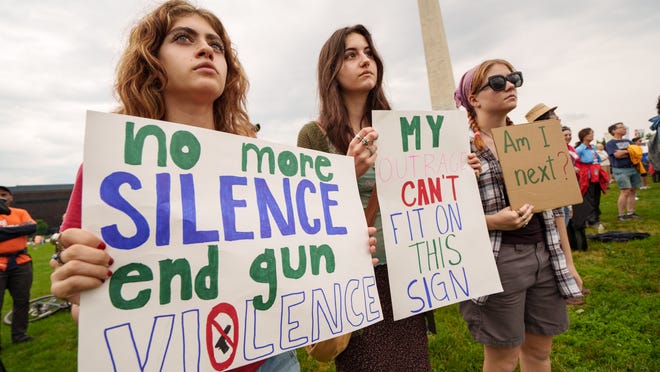COLUMBUS, Ohio — School districts across Ohio will be able to authorize teachers, principals and other staff to carry firearms into classrooms this fall after 24 hours of training.
The new law, signed Monday by Republican Gov. Mike DeWine, will lower the required training hours for armed school personnel from about 700 hours to four scenario-based training hours, plus a maximum of 20 hours for first-aid training, history of school shootings and reunification education.
The signing came the same day Ohio’s new constitutional carry law took effect.
“In life we make choices, and we don’t always know what the outcome is going to be,” DeWine said at a news conference. “What this Legislature has done, I’ve done by signing it, is giving schools an option based on their particular circumstances to make the best decision they can make with the best information they have. That’s all any decision-maker can do.”
Ohio school districts are not required to allow staff to carry firearms under the law. House Bill 99 allows local boards of education to decide whether they want staff to carry firearms at all and how much training will be required.
DeWine said he directed the Ohio School Safety Center to require at least 24 hours of training and eight years of requalification training each year. The move appeared aimed at eliminating confusion among lawmakers over whether the bill established a minimum number of training hours.
Private businesses that want to train school staff must also meet the 24-hour minimum to have their curriculum approved, DeWine said.
Will the new law prevent gun violence?
Democrats and gun control advocates panned the new law, saying it won’t do enough to prevent gun violence and mass shootings. Law enforcement officials have also said 24 hours is not enough time to learn how to safely use a firearm.
Opponents argued DeWine walked back on promises to address gun violence after a gunman killed nine people in Dayton in 2019. The governor responded to cries of “do something” by unveiling a package of gun control reforms, but they never went anywhere in the GOP-controlled Legislature.
“I feel like a putz for believing him,” Toledo Mayor Wade Kapszukiewicz said. “He did something, alright. He gave in like a coward, and he made the problem worse.”
DeWine has signed three bills loosening gun restrictions since the shooting.
“It’s a complete bastardization of what people said in Dayton, frankly,” said former Dayton Mayor Nan Whaley, who is running for governor against DeWine. “This is not what the people of Dayton had in mind when they started chanting that.”
During Monday’s news conference, DeWine urged lawmakers to consider provisions of the 2019 legislation that would increase penalties for straw purchases and prevent people with severe mental health conditions from possessing a firearm.
DeWine touts school safety efforts
DeWine’s signature puts an end to years of debate over how many hours of firearm training Ohio teachers should have.
Parents in the Madison Local Schools district in southwest Ohio sued the district over its armed teacher program, arguing that the training required – about 24 hours – violated state law. The Ohio Supreme Court ruled for the parents in 2021.
The court ruled in a 4-3 decision that Ohio Revised Code required anyone authorized to carry a gun on school grounds to have 20 years of experience or peace officer training. DeWine argued the ruling made firearm training unmanageable for school districts that wanted to permit it.
But some law enforcement disagreed.
“I think it’s a horrible idea to arm our teachers,” Columbus Police Chief Elaine Bryant said. “There’s a lot of training that’s involved in that. It’s naïve to believe that is something we can put on them and expect them to respond to from a law enforcement perspective.”
The governor used Monday’s news conference to highlight other school safety initiatives that he’s rolled out since the elementary school shooting in Uvalde, Texas. The new capital budget includes $100 million in grants that schools can use to upgrade building security. The state is also investing in training to help school staff identify behavioral health problems in students.
“We are trying to do and have been trying to do every single day things that people keep safer – keep kids in school safer but also these same children who go home to neighborhoods where there’s violent crime and repeat violent offenders,” DeWine said. “Their lives are important, too. All children’s lives are important.”


